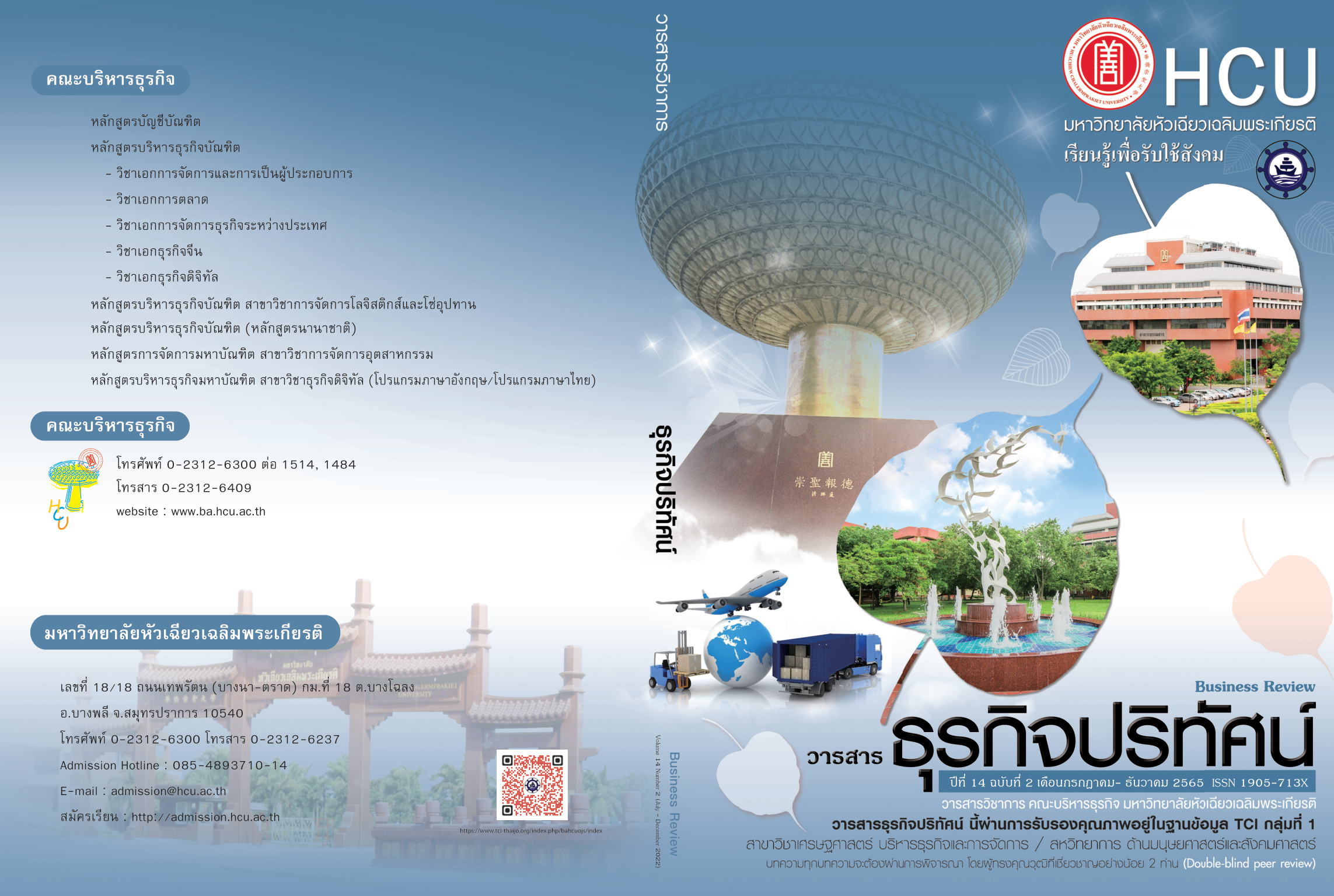The Push and Pull Factors of Japanese tourists that affect traveling to Thailand
Keywords:
Push Factor, Pull Factor, Japanese TouristAbstract
The study aims to (1) to study the behaviors that are push factors of Japanese tourists traveling to Thailand (2) to study the Marketing Mix (8P’s) that a pull factors of Japanese tourists traveling to Thailand and (3) to propose guidelines of marketing’s plan develop of Thailand tourism’s industry for Japanese’s tourist. This Research is a quantitative research, data was collected using questionnaires for the 400 samples by Convenience Sampling method, the descriptive statistics were used to describe the characteristics of the data and the test statistics using Chi-Square method. The results had shown that the push factors of Japanese tourists traveling to Thailand are the beautiful tourist attractions, interesting cultures and traditions. And pull factors of Japanese tourists traveling to Thailand are various tourism activities and reasonable cost. Moreover, it shows the demographics of the Japanese tourists such as age, status and career affects the pull factors. It also shows that the Japanese tourists with different intended level of education, status, career and monthly salary will have different attitudes toward the pull factors in making a decision to travel to Thailand at the 0.05 level of significance
References
กระทรวงการท่องเที่ยวและกีฬา. (2559). แผนพัฒนาการท่องเที่ยวแห่งชาติ พ.ศ. 2560–2564. กรุงเทพฯ: กระทรวงการท่องเที่ยวและกีฬา.
กระทรวงการท่องเที่ยวและกีฬา. (2562). จำนวนนักท่องเที่ยวระหว่างประเทศของไทย ปี 2561. สืบค้นเมื่อ 3 ตุลาคม 2562, เว็บไซต์: https://www.mots.go.th/more_news_new.php?cid=583
กฤษณพงค์ พูตระกูล. (2544). ความรู้ และพฤติกรรมของตำรวจกองปราบปรามในการประหยัดพลังงานไฟฟ้า. วิทยานิพนธ์ ศษ.ม. มหาวิทยาลัยมหิดล, นครปฐม.
กรุงเทพธุรกิจ. (2561). ททท. ปิ๊งไอเดียใหม่กระตุ้นเมืองรอง. กรุงเทพธุรกิจ. สืบค้นเมื่อ 17 ธันวาคม 2561, เว็บไซต์: https://www.bangkokbiznews.com/pr/detail/52470.
ดวงดาว โยชิดะ, ชวลีย์ ณ ถลาง, สุทธินันทน์ พรหมสุวรรณ, และสหนนท์ ตั้งเบญจสิริกุล. (2561). ความคาดหวังและความพึงพอใจในการเดินทางท่องเที่ยวประเทศไทยของนักท่องเที่ยวผู้สูงอายุชาวญี่ปุ่น. วารสารวิชาการมหาวิทยาลัยธนบุรี, 12(29), 127-137.
ดวงใจ กาญธีรานนท์, และสมบัติ กาญจนกิจ. (2556). แนวทางการส่งเสริมการท่องเที่ยวในประเทศไทยของนักท่องเที่ยวญี่ปุ่นกลุ่มสตรีวัยทำงาน. วารสารวิทยาศาสตร์การกีฬาและสุขภาพ, 14(3), 172-185.
ฉลองศรี พิมลสมพงศ์. (2556). การวางแผนและพัฒนาตลาดท่องเที่ยว. พิมพ์ครั้งที่ 11. กรุงเทพฯ: มหาวิทยาลัยเกษตรศาสตร์.
ฉลองศรี พิมลสมพงศ์. (2557). การวางแผนและพัฒนาตลาดท่องเที่ยว. พิมพ์ครั้งที่ 12. กรุงเทพฯ: มหาวิทยาลัยเกษตรศาสตร์.
นิคม จารุมณี. (2535). การท่องเที่ยวและการจัดการอุตสาหกรรมท่องเที่ยว. กรุงเทพฯ: โอเดียนสโตร.
วินิจ วีรยางกูร. (2532). การจัดการอุตสาหกรรมท่องเที่ยว. กรุงเทพฯ: มหาวิทยาลัยเกษตรศาสตร์.
นภัสนันท์ ทองอินทร์. (2562). แนวทางการพัฒนาพื้นที่ท่องเที่ยวในอำเภอพระนครศรีอยุธยาเพื่อให้สอดคล้องกับความต้องการของนักท่องเที่ยวชาวญี่ปุ่น. วารสารวิทยาการจัดการปริทัศน์, 20(1), 33- 41.
สุรีย์ เข็มทอง. (2554). ความรู้เบื้องต้นเกี่ยวกับการตลาดการท่องเที่ยวและการโรงแรม. เอกสารการสอนวิชาการจัดการการตลาดเพื่อการท่องเที่ยวและการโรงแรม หน่วยที่ 1. กรุงเทพฯ : สํานักพิมพ์มหาวิทยาลัยสุโขทัยธรรมาธิราช.
สุรีรัตน์ เตชาทวีวรรณ. (2545). พฤติกรรมนักท่องเที่ยว. เอกสารประกอบการสอนวิชาพฤติกรรมนักท่องเที่ยว.คณะวิทยาการจัดการ. มหาวิทยาลัยขอนแก่น.
สำนักงานการท่องเที่ยวและกีฬา. (2552). คู่มือกระบวนการส่งเสริมด้านการท่องเที่ยวจังหวัดระนอง. กรุงเทพฯ: สำนักงานการท่องเที่ยวและกีฬา.
อรจนา จันทรประยูร. (2555). ความแตกต่างระหว่างพฤติกรรมของนักท่องเที่ยว. เชียงใหม่: มหาวิทยาลัยแม่โจ้.
อตุลย์ จาตุรงคกุล. (2543). พฤติกรรมผู้บริโภค. กรุงเทพฯ: มหาวิทยาลัยธรรมศาสตร์.
อุษณีย์ ผาสุข. (2557). การศึกษาภาพลักษณ์การท่องเที่ยวของประเทศไทยในมุมมองของนักท่องเที่ยวชาวญี่ปุ่น. วิทยานิพนธ์ ศศ.ม, มหาวิทยาลัยพะเยา.
Kotler, P., and Armstrong, G. (1996). Principles of Marketing (7th ed.). Englewood: Prentice Hall.
Thaihotelbusiness. (2561). Tourism trend in Thailand. Retrieved October 3, 2019, website:https://1th.me/GpoFf
Yamane, T. (1973). Statistics: An Introductory Analysis. 3rdEd.New York. Harper and Row Publications.
Downloads
Published
How to Cite
Issue
Section
License
Copyright (c) 2022 Business Review Journal

This work is licensed under a Creative Commons Attribution-NonCommercial-NoDerivatives 4.0 International License.
All articles published in the Business Administration and Management Journal Review are copyrighted by the journal.
The views and opinions expressed in each article are solely those of the individual authors and do not represent those of Huachiew Chalermprakiet University or any other faculty members. Each author is fully responsible for the content of their own article. Any errors or issues found are the sole responsibility of the respective author.




